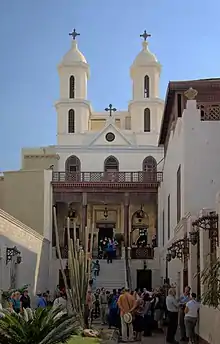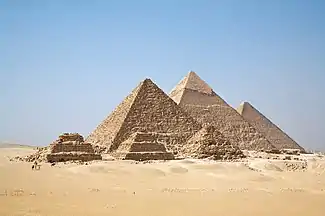Islamization of Egypt
The Islamization of Egypt occurred as a result of the Muslim conquest of Roman Egypt by the Arabs led by the prominent Muslim general Amr ibn al-Aas, the military governor of the Holy Land. The masses of locals in Egypt and the Middle East underwent a large scale gradual conversion from Christianity to Islam, accompanied by heavy taxes for those who refused to convert.[1] This is attested to by John of Nikiû, a coptic bishop who wrote about the conquest, and who was a near contemporary of the events he described. The process of Islamization was accompanied by a simultaneous wave of Arabization. These factors resulted in Islam becoming the dominant faith in Egypt between 10th and 12th century, Egyptians acculturating into an Islamic identity and then replacing Coptic and Greek, which were spoken as a result of the Greek and Roman occupation of Egypt, languages with Arabic as their sole vernacular which became the language of the nation by law.[2]

Part of a series on the |
||||||||||||||||||
|---|---|---|---|---|---|---|---|---|---|---|---|---|---|---|---|---|---|---|
| History of Egypt | ||||||||||||||||||
 | ||||||||||||||||||
|
||||||||||||||||||
|
||||||||||||||||||
|
||||||||||||||||||
|
||||||||||||||||||
|
||||||||||||||||||
|
||||||||||||||||||
|
| ||||||||||||||||||

Islamic links to Coptic Egypt predates its conquest by the Arabs. According to Muslim tradition, Mohammed married a Copt; Maria al-Qibtiyya. In 641 AD, Egypt was invaded by the Arabs who faced off with the Byzantine army. Local resistance by the Egyptians began to materialize shortly thereafter and would last until at least the ninth century.[3][4]
The Arabs imposed a special tax, known as jizya, for those who didn't want to accept Islam, the Christians who acquired the protected status of dhimmis, the taxation was justified on protection grounds since local Christians who kept their religion were never drafted to serve in an army. Arab rulers generally preferred not to share the rule with Coptic Christians in their towns and established new colonies, like Fustat. Heavy taxation at times of state hardships was a reason behind Coptic Christians organizing resistance against the new rulers. This resistance mounted to armed rebellions against the Arabs in a number of instances, such as during the Bashmurian revolt in the Delta.
The Arabs in the 7th century seldom used the term Agiptous, and used instead an Arabic language version of the term which is Al Qibt, which was then adopted into English as Copt, to describe the locals in Egypt they kept using the term to refer to all Muslims and Christians Egyptians up until the Mamluk rule that legally banned the term on Muslims and associated their native language to paganism. Thus, only Christian Egyptians became known as Copts or Orthodox Copts, and also the non-Chalcedonian Egyptian Church became known as the Coptic Church. The Chalcedonian Church remained known as the Melkite Church. In Coptic, which is written using a Greek alphabet, Coptic Egyptians referred to themselves as ⲛⲓⲣⲉⲙⲛ̀ⲭⲏⲙⲓ (/ni-rem-en-kēmi/ "Egyptians"). Religious life remained largely undisturbed following the establishment of Arab rule, as evidence by the rich output of Coptic Orthodox Christian arts in monastic centers in Old Cairo (Fustat) and throughout Egypt. Conditions, however, worsened shortly after that, and in the eighth and ninth centuries when Muslim rulers banned the use of human forms in art (taking advantage of an iconoclastic conflict in the European ruled Byzantium) and consequently destroyed many Coptic christian paintings mainly of Jesus and frescoes in churches.[5]
Coptic Christians lost their majority status after the 14th century,[6] as a result of the intermittent persecution and the destruction of the Christian churches there.[7] From the Muslim conquest of Egypt onwards, the Coptic Christians were persecuted by different Muslims regimes,[8] such as the Umayyad Caliphate,[9] Abbasid Caliphate,[10][11][12] Fatimid Caliphate,[13][14][15] Mamluk Sultanate,[16][17] and Ottoman Empire; the persecution of Coptic Christians included closing and demolishing churches and forced conversion to Islam.[18][19][20]
The Fatimid period in Egypt was a time of relative tolerance. The Fatimid rulers employed Copts in the government and participated in Coptic and local Egyptian feasts. Major renovation and reconstruction of churches and monasteries were also undertaken. Coptic arts flourished, reaching new heights in Middle and Upper Egypt.[5]
See also
References
- Conversion, Exemption, and Manipulation: Social Benefits and Conversion to Islam in Late Antiquity and the Middle Ages: Forcing taxes on those who refuse to convert (PDF),
ʿUmar is depicted as having ordered that "the poll-tax should be taken from all men who would not become Muslims"
- Clive Holes, Modern Arabic: structures, functions, and varieties, Georgetown University Press, 2004, ISBN 978-1-58901-022-2, M1 Google Print, p. 29.
- Mawaiz wa al-'i'tibar bi dhikr al-khitat wa al-'athar (2 vols., Bulaq, 1854), by Al-Maqrizi
- Chronicles, by John of Nikiû
- Kamil 1990, p. 41.
- Shea, Nina (June 2017). "Do Copts have a future in Egypt". Foreign Affairs. Archived from the original on 2017-06-20.
- Etheredge, Laura S. (2011). Middle East, Region in Transition: Egypt. Britannica Educational Publishing. p. 161. ISBN 9789774160936.
- Refugees, United Nations High Commissioner for. "Refworld | World Directory of Minorities and Indigenous Peoples – Egypt : Copts of Egypt". Refworld. Retrieved 2020-06-15.
- H. Patrick Glenn, Legal Traditions of the World. Oxford University Press, 2007, p. 219.
- Goddard, Hugh (2000). A History of Christian–Muslim Relations. Rowman & Littlefield. p. 71. ISBN 1566633400. Retrieved 20 January 2016.
- Feder, Frank (2017). "The Bashmurite Revolts in the Delta and the 'Bashmuric Dialect'". In Gabra, Gawdat; Takla, Hany N. (eds.). Christianity and Monasticism in Northern Egypt: Beni Suef, Giza, Cairo, and the Nile Delta. American University in Cairo Press. pp. 33–35.
- Lapidus, Ira M. (1972). "The Conversion of Egypt to Islam". Israel Oriental Studies. 2: 257.
- Robert Ousterhout, "Rebuilding the Temple: Constantine Monomachus and the Holy Sepulchre" in The Journal of the Society of Architectural Historians, Vol. 48, No. 1 (March, 1989), pp.66–78
- John Joseph Saunders (11 March 2002). A History of Medieval Islam. Routledge. pp. 109–. ISBN 978-1-134-93005-0.
- Marina Rustow (3 October 2014). Heresy and the Politics of Community: The Jews of the Fatimid Caliphate. Cornell University Press. pp. 219–. ISBN 978-0-8014-5529-2.
- Teule, Herman G. B. (2013). "Introduction: Constantinople and Granada, Christian-Muslim Interaction 1350-1516". In Thomas, David; Mallett, Alex (eds.). Christian-Muslim Relations. A Bibliographical History, Volume 5 (1350-1500). Brill. p. 10. ISBN 9789004252783.
- Werthmuller, Kurt J. (2010). Coptic Identity and Ayyubid Politics in Egypt, 1218-1250. American Univ in Cairo Press. p. 76. ISBN 9780805440737.
- Lyster, William (2013). The Cave Church of Paul the Hermit at the Monastery of St. Pau. Yale University Press. ISBN 9789774160936.
Al Hakim Bi-Amr Allah (r. 996—1021), however, who became the greatest persecutor of Copts.... within the church that also appears to coincide with a period of forced rapid conversion to Islam
- N. Swanson, Mark (2010). The Coptic Papacy in Islamic Egypt (641-1517). American Univ in Cairo Press. p. 54. ISBN 9789774160936.
By late 1012 the persecution had moved into high gear with demolitions of churches and the forced conversion of Christian ...
- ha-Mizraḥit ha-Yiśreʼelit, Ḥevrah (1988). Asian and African Studies, Volume 22. Jerusalem Academic Press. Muslim historians note the destruction of dozens of churches and the forced conversion of dozens of people to Islam under al-Hakim bi-Amr Allah in Egypt ...These events also reflect the Muslim attitude toward forced conversion and toward converts.
Sources
- Betts, Robert B. (1978). Christians in the Arab East: A Political Study (2nd rev. ed.). Athens: Lycabettus Press.
- Charles, Robert H. (2007) [1916]. The Chronicle of John, Bishop of Nikiu: Translated from Zotenberg's Ethiopic Text. Merchantville, NJ: Evolution Publishing.
- Kamil, Jill (1990). Coptic Egypt: History and a Guide (Revised ed.). American University in Cairo Press.
- Meyendorff, John (1989). Imperial unity and Christian divisions: The Church 450-680 A.D. The Church in history. 2. Crestwood, NY: St. Vladimir's Seminary Press.
- Ostrogorsky, George (1956). History of the Byzantine State. Oxford: Basil Blackwell.